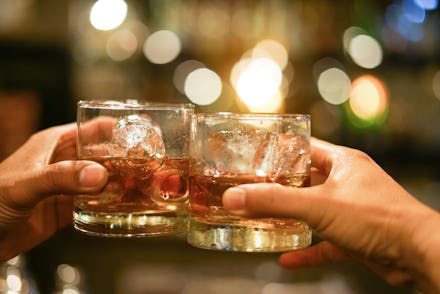Nothing about whiskey is inherently manly. So why do we treat it that way?

Gender is a box we’re placed into before we can even roll over or hold our bulbous baby heads up. It’s also an illusion, even if so many people still reject the idea of intentionally stepping out of that box. Trans people’s simple request to be referred to by their correct pronoun often met with ignorance, both purposeful and unintentional. Even allies can stay sleeping — I admit, understanding how and why to use non-binary pronouns took a little getting used to before a coworker of mine taught me their invaluable perspective.
This restrictive set of ideas about gender is perhaps more painfully evident at a bar. Ok, now hear me out: Although my go-to is a Glenlivet, neat, I never fail to get extensive commentary from everyone when I have a brightly colored drink in my hand. The idea that it’s wild for someone who identifies as male to enjoy a fruity margarita is a ridiculously rigid relic from the time of petticoats and bowler hats. And even as the concept of gender evolves, our social assumptions of alcohol beverages feel stale and stagnant.
First, why are alcoholic drinks even gendered anyway? Historical mores and bright colors both contribute to this weird masculine versus feminine beverage trope. In fact, back around the time of prohibition, a woman was considered to be of “loose moral” (alas, life before WAP and WAP-adjacent anthems) if she was even seen drinking at a bar.
Over time, that asinine stereotype faded, but many of those gendered ideas about alcohol being for men held on like gum under a dive bar table. This could be why women were (and are still) marketed drinks that appear gentler, sweeter, and more "fun."
There’s also the language around drinking to consider. For example, calling a drink The Incredible Hulk will probably make a man who wouldn’t order a Verdant Lady take a sip, even though the latter is more alcoholic. That traces back to the way language has evolved over time.
Gendering alcoholic drinks feels inevitable, given the way we have historically personified things in general. When people talk about a sports car as a “she” or a power tool as a ”he” they’re using a language concept called metaphorical gender. It’s a tool to easily describe something without going into detail, due to some random attributes. The sports car might be a “she,” to a man, perhaps, because he’s riding (in) her. Ah, heteronormity.
We also use gendered language nowadays to refer to things that sketch out the idea of what we are referring to, based on our preconceived notions about men and women. “It’s almost as if the referenced gender has provided an adjective that helps describe the subject matter being discussed to visualize context,” says says Dana McNeil, a San Diego-based therapist. “Unfortunately, we use these descriptors that introduce stereotypes that are incredibly incorrect, sometimes painful, and not helpful in the long run.”
This is annoying to those of us, like me, who stray out of the binary in our expressions. But for non-cis folks, it’s worse than annoying — these stereotypes can be constant painful reminders of intolerance toward trans people, all at a venue specifically created for relaxation and enjoyment.
Behind the bar, the people who put your drinks also witnessed the stereotypes are true well. My grade school classmate, Matthew Lewis, is bartender in Maryland these days, and he told me about it his most memorable drink order when a group of men who he called “giant,” came in and ordered a round of Woo-Woos, a drink with a feminine name and fruity ingredients, and one Sex on the Beach “for the big guy” — a guys who was even larger and taller to Matt’s 6’4” beefy stature. It’s gentle comedy when a Goliath of a man orders a fruity bev because he wants to, but less fun when someone considers whisky too butch of a drink for a woman. It’s direct participation in gender policing, and it happens more than we realize.
Since the beginning of alcohol marketing, sexism has reigned. Just look at advertisements for beer, a microcosm of how advertising in the past has bled into today. I mean, look at any gift guide for men and you’ll see whiskey stones and scotch glasses, beer-making sets and decanters. In womens’ guides, there are sometimes, cute, delicate things such as fluted glassware.
Gendered booze messaging seeps into every aspect of pop culture, too. See Don Draper in Mad Men (and also note how every douche-bro in the world loves him so deeply). His “sexy” character sold outdated examples of gender to the modern world. And these tropes are gobbled up because humans have not really changed that much when it comes to categorizing people by their perceived place in the binary gender system.
Regardless of whether you’re nursing a cosmopolitan or shooting Jagermeister, it might be time to ask yourself why. You might find yourself craving something new. It took me a little while to unlearn the discomfort of a giant frilly mermaid frosè in my hand. And letting go gave me an unparalleled buzz.